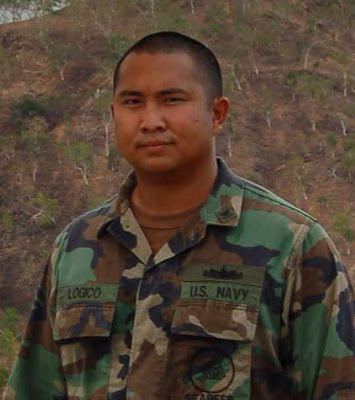"Two of the shooting positions required me to lay on my belly in the dirt. What sucked about the dirt was that every time I laid down, so would my kevlar helmet and I (like most bullets) have not yet developed the ability to see through kevlar." -MC2 Amara Timberlake
Both are at Fort Dix, NJ, undergoing training to prepare them for one-year deployments to the sandbox. Timberlake's an alternate to go to Afghanistan, and Nguyen's going to Iraq.
To say this is a change for them would be a gross understatement. Read about their experience below, and witness The Transformation!
--- What stage of your training are you in right now?
Timberlake: Unlike RTC or A-school our training is pretty unorganized and not really divided up into any fields of study or stages. We basically get into the the Army's Basic Combat Skills Training classes whenever and where ever we can. For example, Nguyen's platoon did hand-to-hand combat training last weekend but I won't get that training until tomorrow. We're both almost two weeks in now which leaves about 2 more to go here at Ft. Dix.
That's Timberlake in the front.
--- How different is your current environment? Do you feel like a fish out of water right now?
Timberlake: Fort Dix reminds me A LOT of Ft. Meade. lol. It's got the Class 6 Shoppette, the PX, and all of those brown little road signs that they had around DINFOS. This base is a lot bigger though because it's actually a joint base. It's call Joint Base Fort Dix-Lakehurst-Macguire. We don't do too much work with the Army, they facilitate most of our training but the one's in charge here are all Navy. The Air Force is here doing the same type of training for similar missions so we see them around often too.
Nguyen: Not really, my class has it's own chain of command. It's like any other department. They put us in little platoon/division. It's nice to know who to go to if you need help. So far I think the Army and prior classes like our organization skills. The galley here (which the Army calls "DFAS") is free and delicious. The first day felt weird, couldn't pin point it to being surrounded by different branches or eating good food. Then I notice that I was eating with khakis, and I wonder why we don't do this now in the Navy.
Timberlake's off to a rough start with the battle rattle.
"The first two times I shot with the gas mask I hit nothing. I couldn’t see through the sights on the gun because I couldn’t get my face close enough, because I had a giant, dirt filled gas mask on."
-MC2 Amara Timberlake
--- Has your IA experience been what you expected?
Timberlake: So far my IA experience has been completely different from what I expected. IA stands for individual augmentee. You are one Sailor that goes out to augment one Navy unit. So far I have been in all Navy barracks and the way the platoons are divided is much like the way departments and divisions are set up on a ship. We have two officers, a chief, and a handful of first classes, a ton of 2nds and two 3rds. ALL MC's. So I'm honestly finding it a bit frusterating that I have this long chain of command of people that I didn't come here with and won't necessarily be moving on with either. You know me, I just want to be an individual.
Nguyen: Most of our days is just watching power points. whether it's about what we can and cannot do, diseases, weather, and a little language. We've done a little hands on training like Humvee rollover and MACP, which was my favorite. It reminded me a lot of my own gym. We've been knocking out our classes pretty quick and we might finish just a little early.
Nguyen on the way to the firing range.
--- So what's the next step for you guys?
Timberlake: For me, I don't quite know what's next. My orders have me coming back to Nimitz May 11th, so I'm waiting on an Order modification to tell me otherwise. If I don't get the ORMOD, I will be going back to Washington while the rest of my training group moves on to Kuwait. I'll be on standby there with my equipment until August 19th. If they don't call me, I will return my equipment and go on with my life. If they do call me, I will most likely spend eight months in Afghanistan or be reassigned to a different mission. As you know, I REALLY don't want to come back to the ship. It's nothing against Nimitz honestly, I'm just really ready to do something different and I feel like this is it, right now.
Nguyen: Tomorrow I start Humvee training and I can't wait to start driving!!! I think they are the coolest vehicle on the planet. You have to do all the pre reqs before you start for the Navy and Army (which i'm doing as we speak). Eventually we'll do the range and go out for 3 days and 2 nights for survival training. So after all the briefs, I think it'll get better.
-----------------------
Keep making us proud guys! For more on her IA experience, check out Timberlake's blog here.
























